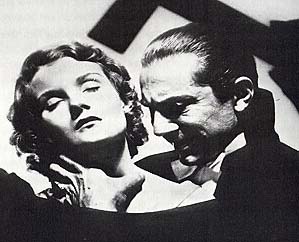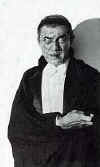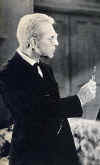
Browning's
Dracula Reconsidered
by William Max Miller
Tod Browning's 1931 Dracula
receives more than its share of brickbats from critics who contend that Browning
botched two thirds of the film. After giving almost unanimous praise to the
Transylvanian sequences which open the film, they sharpen their fangs and start
gnawing away at the scenes set in England. The critics disparage the stationary
camera work in this part of Dracula, and their descriptions bristle with
negative adjectives like "stage bound," "static," and "dull." But could all these genre pundits be missing something?
True, Browning definitely slows the pace significantly when
his camera migrates from adventurous Transylvania to the stuffy sitting rooms
and boudoirs of Dr. Seward's English estate-by-the-asylum. But even here
one can find a subtle symbolism, for ominous fleur de mal sprout unobtrusively
amidst all the stagy decor. While Lucy and Mina talk about the mysterious
Dracula, the shadow of a bat hovers portentously over the
table lamp behind them, as though awaiting the Count's nocturnal arrival. The
kitsch ceramic lamp by Lucy's bedside is decorated with the figures of
three dancing women, a reminder of Dracula's three brides and also a forewarning
that Lucy is about to join them among the Undead. Later, the same lamp
mysteriously appears in Mina's bedroom, boding a similar fate for her. The
England sequences of Dracula are far from being devoid of visual
symbolism. Viewers simply have to look more closely for it in this part of the
film than they did during the Gothic extravaganza of the Transylvanian
scenes.
 But
the real key to understanding the stylistic
differences between the first and final two thirds of Browning' Dracula
can be found by paying closer attention to the figure of Dr. Van Helsing.
Browning's presentation of this character, so skillfully portrayed by Edward
Van Sloan, is more complex than today's viewer usually imagines. This elderly
doctor is typically viewed as the embodiment of absolute Goodness and Light in
opposition to Dracula's absolute evil, yet there are certain scenes in the film
that cast doubt on this easy black-and-white interpretation.
But
the real key to understanding the stylistic
differences between the first and final two thirds of Browning' Dracula
can be found by paying closer attention to the figure of Dr. Van Helsing.
Browning's presentation of this character, so skillfully portrayed by Edward
Van Sloan, is more complex than today's viewer usually imagines. This elderly
doctor is typically viewed as the embodiment of absolute Goodness and Light in
opposition to Dracula's absolute evil, yet there are certain scenes in the film
that cast doubt on this easy black-and-white interpretation.
Watch as Van Helsing examines the body of Lucy in the
surgical theater. He looms above her corpse with the same calculated, cold purposefulness
which earlier animated Dracula as he bent over the fallen body of Renfield back
in his castle. Just like Dracula, Van Helsing wishes to extract something from
Lucy. Dracula has drained her of blood, and now it's Van Helsing's turn to drain
her of information, the lifeblood of the scientist. The other doctors and
medical students who watch from their encircling seats look down like hungry
vultures while they watch the older professor (their "master") conduct
his grim post mortem ritual. They remain so motionlessly intent on the
activities of Van Helsing that it's hard to tell if these "students" are actors or
figures painted on a backdrop, and their rigid downward-peering forms lend a
disturbing Kafkaesque flavor to the scene.
Later in the film, we see Van Helsing approach Mina in a most
intriguing manner after she informs him of her strange feelings of
weakness and describes the unpleasant "dream" she'd had the night
before. As he nears her, Van Helsing's movements take on an intrusiveness that
is unmistakably threatening. Holding his hands in a peculiar fashion, very similar to the
stylized hand-movements of Lugosi's Dracula, he seems to wait for a moment of
vulnerability and suddenly pounces on the resisting girl's throat! This scene
plays like an inverted deja vu reenactment of Dracula's own nocturnal
attack on Mina, and hints at an interpretation of medical scientists like Van
Helsing that is anything but favorable.
hand-movements of Lugosi's Dracula, he seems to wait for a moment of
vulnerability and suddenly pounces on the resisting girl's throat! This scene
plays like an inverted deja vu reenactment of Dracula's own nocturnal
attack on Mina, and hints at an interpretation of medical scientists like Van
Helsing that is anything but favorable.
Van Helsing's glasses provide another subtle clue that his
character is not as simple as we might first assume. Strangely thick
and goggle-like, the lenses of these weird glasses call attention to Van
Helsing's eyes just as blatantly as the pin-hole lighting that is used to
emphasize the power of Dracula's hypnotic gaze. The symbolism of the eye,
especially of the evil eye, figures prominently in Browning's Dracula.
The peasants in Transylvania make signs that are traditionally used against the evil eye. Mina's
eyes widen when she relays her dream of glowing eyes in the night. Dracula's
eyes light up like balefires and stare intently when he gives
hypnotic commands to Renfield. And the power of Van Helsing's eyes are also
unnaturally magnified by his thick glasses. Like Dracula's, his eyes are more
powerful than those of normal humans. His gaze penetrates as deeply as the
vampire's into hidden things, for he is the only one capable of discerning the
presence of the Undead in the happenings at Seward's sanitarium. But unlike
Dracula, whose vision is supernaturally empowered, Van Helsing's perspective is
magnified by science and the technology of the lens. Dracula's view is that of
the occult seer, whereas Van Helsing's is that of the microscope.
And here we find the very contrast which viewers see between
the Transylvanian opening of Dracula and the other parts of the film.
When we are in Dracula's world, the camera adopts the king vampire's point of
view, and encompasses sweeping moonlit vistas and vast cobwebbed spaces. It
glides effortlessly down the Borgo Pass and through the shadowy corridors of
Dracula's castle, taking bat-like passes at the actors. But when we enter
England, we find ourselves in a world where  the powers of Van Helsing hold sway,
and the camera takes on his methodical point of view. It surveys each sequence
from a patient, often stationary perspective, and invites us to examine scenes
in a linear progression like slides under a microscope.
the powers of Van Helsing hold sway,
and the camera takes on his methodical point of view. It surveys each sequence
from a patient, often stationary perspective, and invites us to examine scenes
in a linear progression like slides under a microscope.
Perhaps the recent release of the DVD version of Browning's Dracula
will reawaken a new interest in the film and enable audiences to appreciate it as
a coherent whole. Far from giving audiences just one third of a good film, Dracula
presents an interesting cinematic example of shifting perspectives. Its stage-like quality functions as part of the message being conveyed, and helps contrast the supernaturalism of Dracula with the orderly, logical world view of Van Helsing. The Van
Helsing sequences differ from the Transylvanian scenes because Van Helsing
resided in a different domain and exercised a kind of power which differed from
that of Count Dracula's. And Browning presents the conflict between these
characters in ambiguous terms, confronting us with the disturbing reality
that Van Helsing's powers, which derive from the science we all run to for
protection against superstition, have a dark side that can become every bit as menacing as those
of the vampire.
Return to Reflections